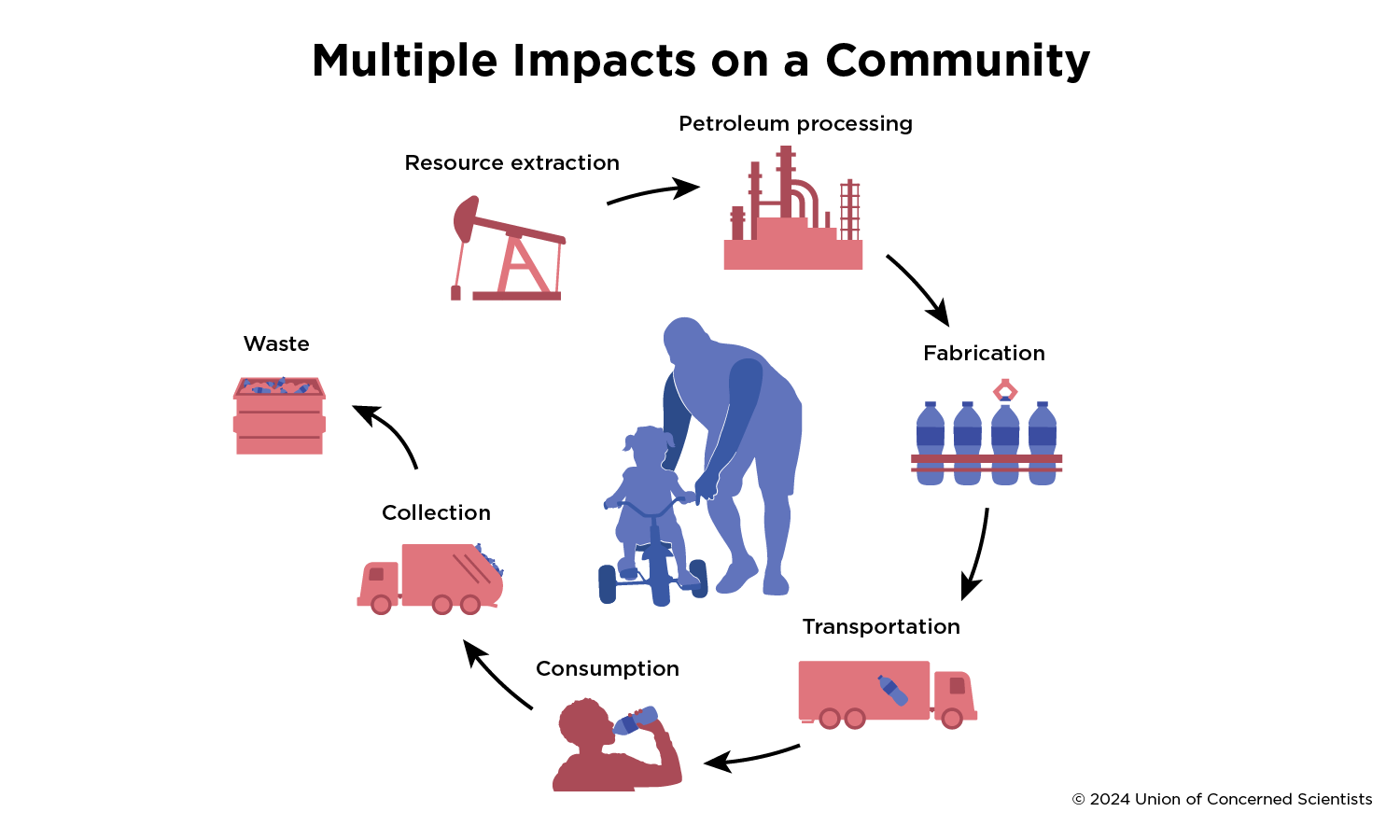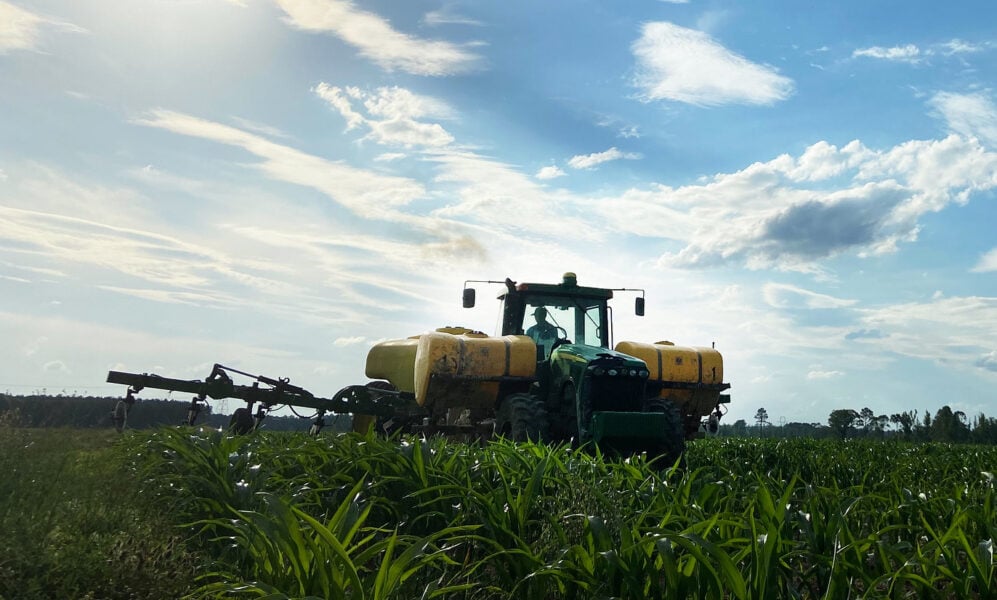The Union of Concerned Scientists (UCS) has been advocating for an equitable, sustainable, resilient, and healthy food and farm system for many years. Transitioning to such a system will require US agriculture to reduce its dependency on, and overapplication of, synthetic fertilizers.
Over the next few years, UCS will be shining a light on the fertilizer industry and the impact it has on people and the environment. Fertilizer comes from many different sources, dispersed globally and involving a complex web of international trade pathways, geopolitics, and multiple chemical processes that can harm people and the environment in many different ways. And the harmful effects of fertilizers rarely come without simultaneous exposure to other harmful substances like fossil fuels—a phenomenon known as cumulative impacts.
In a recent blog post, my UCS colleague Kristie Ellickson defined the concept of cumulative impacts as a necessary consideration for improving US environmental protection regulations by accounting for multiple health, social, and environmental stressors and burdens rather than one at a time (as today’s fragmented system of environmental protection does). The discussion around cumulative impacts is critical at this moment in time and history because it provides an overall framework for the Environmental Protection Agency (EPA) to offer better public health protection. Moreover, this discussion is especially relevant as we review the EPA’s Interim Cumulative Impacts Framework and provide public comments. Due to the recent rescission of several environmental justice executive orders that specifically call for consideration of cumulative impacts, it becomes even more important to support state and local action on this issue.
Let’s look at the cumulative impacts of fertilizer production, especially from the environmental and human health lens.
The main ingredients of synthetic fertilizers
Nutrients like nitrogen, phosphorus, and potassium—the “holy trinity” popularly known as NPK by private industry—are deemed essential for cultivating crops. Because of this, these nutrients are often overapplied to crop fields in the form of synthetic fertilizers. But the production and overapplication of synthetic fertilizers come with a terrible cost.
Besides the harm to communities from chemical exposures, manufacturing synthetic fertilizers is energy-intensive. Nitrogen fertilizers are manufactured using the Haber-Bosch process, in which atmospheric nitrogen and hydrogen are combined under extremely high pressure and temperature with a metal catalyst (such as iron) to quicken the reaction, producing ammonia gas. The gas is then cooled with the help of cold water to form liquid ammonia, which forms the basis for manufacturing various other nitrogen fertilizer formulations. Natural gas is used as a source of hydrogen and as an energy source for this reaction.
Phosphorus-based fertilizers come from mineral phosphates that are mined in various regions of the world. While a majority comes from Morocco, some is mined in Florida. There have been reports of phosphate mines discharging radioactive waste into the environment, polluting formerly pristine waters, contaminating land, and destroying wildlife habitat.
Potassium (or “potash”) is also mined and then converted into a form used in synthetic fertilizers. There are very few potash manufacturing facilities in the United States, so most is imported from countries including Canada and Russia.
Nitrogen compounds are also mixed with phosphate and potash to produce various multi-nutrient NPK products like diammonium phosphate, the most commonly used fertilizer in our food and farming system.
Hence, the fertilizer manufacturing landscape is extremely broad, with supply chains running all over the globe.

The Community Guide to Cumulative Impacts, recently published by UCS, depicts the multifaceted impact that a product can have on a community throughout its life cycle. For fertilizers, the life cycle begins with the extraction of minerals, refining, and manufacture using fossil fuels. All those steps can release pollutants into a community. Then the fertilizer is transported, sold to farmers who apply it to agricultural fields, and any excess is washed away or builds up in the soil. The pollutants released at each step in the process can harm people who live in nearby communities.
Fertilizers’ impact on the environment
The agricultural industry frequently touts the importance of fertilizers to growing food, but my colleagues and I disagree. Manufacturing fertilizers requires a massive amount of energy, which comes from the burning of fossil fuels that release heat-trapping gases including carbon dioxide (CO2), methane (CH4), ammonia (NH3), and nitrous oxide (N2O). This makes fertilizer manufacturing a major source of global warming emissions that have a dramatic impact on our climate.
Secondly, the quantity of fertilizer consumption has drastically increased in the last few decades. A carefully crafted narrative that more fertilizer means more crop yield and more profits, combined with government subsidies that have favored corporate profits, have allowed giant fertilizer companies to hook farmers on fertilizers. But fertilizer overuse is damaging to soils and environmental health, depleting the ability of soils to absorb water and to store, use, and replenish essential nutrients. Once farmers hop onto this fertilizer treadmill, it is almost impossible to hop off.
These fertilizers are applied far in excess of what is actually needed. More than 50 percent of applied nitrogen and phosphorus fertilizer never reaches the crop plants and is lost to runoff, damaging environmental quality through the overgrowth of algae, which consume all of the dissolved oxygen in water (also called eutrophication), leading to the early death of aquatic life like fishes and plants. Overall, an estimated 60 percent of applied fertilizer remains unused and contributes both directly and indirectly to increases in heat-trapping emissions. Excess fertilizer that remains behind in soil is a pervasive and widely reported problem, leading to emissions of nitrous oxide and methane. These gases are far more potent than carbon dioxide (at least 28 to 80 times for methane and 265 times for nitrous oxide) when it comes to trapping heat. In the recent scientific literature, application of nitrogen fertilizers has been attributed to approximately 11 percent of all heat-trapping emissions globally. For agriculture to become a part of the climate solution, the answer is clear: we need to apply much less fertilizer and eventually transition away from the agrochemical treadmill.
Fertilizers’ impact on people
The reality is that fertilizer manufacturing does not occur in isolation, and the plants are usually located in the vicinity of other fossil fuel industries. For example, an 85-mile stretch along the Mississippi River in Louisiana known as Cancer Alley is home to about 150 polluting fossil fuel facilities, at least three of which are fertilizer manufacturing plants. The pollution released by these facilities affects cities in the area like St. Gabriel (population 6,700) and Donaldsonville (population 6,800), which are already overburdened and are considered environmental justice areas of concern, with exposure to pollution from multiple sources.
Toxic waste discharged from fertilizer manufacturing facilities affects both water and air quality and has a significant impact on human health. Exposure to ammonia can cause severe respiratory distress and lead to diseases like asthma and other respiratory symptoms such as inflammation, coughing, and shortness of breath. Wastewater discharged from fertilizer manufacturing plants contains a cocktail of pollutants like nitrates and suspended and dissolved solids (which is a measure of the amount of particles in water) that can further damage the environment. Excess suspended and dissolved solids give water an unpleasant taste and smell, and can lead to clogging in plumbing systems. Excess nitrates in surface water can lead to eutrophication and impair aquatic life, but when present in drinking water cause severe damage to human health, inducing blood disorders that cause “blue-baby syndrome.”
Where does fertilizer manufacturing stand in the US landscape?
Fertilizer production is on the rise in the United States. The availability of cheaply priced natural gas and geopolitical events like Russia’s war in Ukraine have led the United States to invest in and expand domestic fertilizer manufacturing. In 2024, the Biden administration invested $83 million in 12 states through the Fertilizer Production Expansion Program (FPEP), and another $207 million on similar efforts. The new Trump administration’s attitude toward such programs is still uncertain, but we can safely assume that an administration that is pro-industry, anti-regulatory, and anti-science will prioritize corporate interests over public health and safety.
What is the path forward?
The Trump administration is highly unlikely to move work on cumulative impacts forward given that it is already clawing back public and environmental health protections, like halting DEI (diversity, equity, and inclusion) programs and environmental justice work that make critical investments in programs prioritizing human health, especially in environmental justice communities.
The impact on public health and environmental quality due to fertilizer overapplication and runoff does not pause. Upcoming UCS research will dive deeper into the ecological and public health harms posed by this (and other) practices of US agriculture, and how the adoption of evidence-backed policies can transform our food system to become more resilient in the face of a changing climate.
Current agricultural priorities
The Inflation Reduction Act of 2022 made historic investments to help US agriculture become part of the climate solution, but these funds are jeopardized in the current political climate and are on the chopping block. Similarly, the long-pending next food and farm bill offers an opportunity to create a food and farming system that is more resilient and equitable, but it has been at a stalemate in Congress for months now and its future remains mired in uncertainty.
If you are interested in taking action, join us in protecting climate-focused investments. Another step you can take as a scientist is to join the UCS Science Network and become an advocate to defend against attacks on science and to push for equitable and evidence-backed solutions that protect people’s health and the environment.

